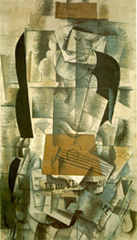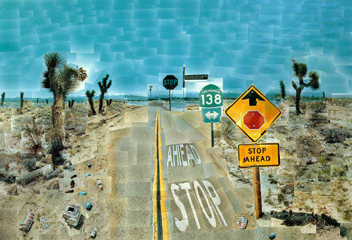Videojoiners
Aleksandra Dulic and Kenneth Newby
presented at: Western Front, 2002
The cubist concept of space and time, extended by David Hockney’s (1999) Joiners, is encoded in the Videojoiners software. Initial experiments in Videojoiners involved a windowing technique, where a window reveals a small portion of live-video input as it moves across the screen. This represents the present-time state of the image segment. Meanwhile the vestiges of past images are still visible in the rest of the screen. The window is drawing the history of the video image through the movement across the screen.

 |
The image rendered as a consequence of this process becomes a collage: a history of the present state with multiple perspectives of the past. < George Braque Woman with a Guitar, 1913, Oil and charcoal on canvas, 130 x 73 cm, Musee National d'Art Moderne, Centre Georges Pompidou, Paris |
David Hockney (1999) in his Joiners applies a similar process by combining the media of photography and collage. His methodology involves taking multiple photographs of a scene and creating a collaged composition from these multiple perspectives and times. His process breaks the perspective of the photographic image, resulting in a new photographic image space. His treatment of architectural spaces alters the perspective of the Quattrocento, as seen by the photo camera, into an inverse perspective. The inverted representation of space was explored by Van Gogh in his painting Chair, as well as in Byzantine fresco paintings, where architectural space is similarly represented.
 |
Hockney refers to this distortion of space as an attempt to approach infinity. The point of reverse perspective is movement - an altered perspective that embeds time. The historical progression here is interesting: Byzantine frescos represented inverse perspective, cubists painted the representation of time, Hockney photographed multiple takes of a scene to construct a cubist-like collage with inverted perspective to reintroduce the element of time into the still photographic image, while our technique treats the collage time image as a time-based process. |
Pearblossom Highway David Hockney Joiners 1-18 April 1986, No. 2 Photographic collage consisting of approximately 750 individual chromogenic prints, 198 x 282 cm, The J. Paul Getty Museum, Los Angeles, California.